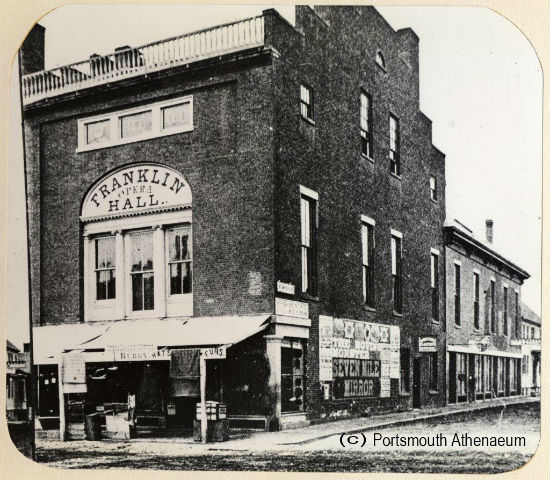Portsmouth’s Other Lost Public Spaces
There has been a considerable amount of publicity lately about replicating The Old State House, which is presumed to have once stood in the center of Market Square. This got our guest historian, J. Dennis Robinson, thinking about other Portsmouth buildings that have also been lost over time.
“Here we go again. Just when you thought Portsmouth’s Old State House was never to return, it’s back in the news. A well-intentioned group wants to build a replica of the 1760-era colonial state house on the site of the city’s federal building off Daniel Street. That dream has been kicking around Portsmouth for almost a century. Architect John Mead Howells tossed out the idea back in the 1930s. I sat on a city committee to study the issue and TMS Architects helped with an in-depth study of the surviving remnants of the building.
The original building stood smack in the middle of the road in Market Square. A few rotted bug-eaten timbers still survive from the interior of the state house. Only one-third of the interior elements remain and are stored in a trailer in Concord. The results of a long-term $250,000 federal study of the Old State House can be seen online.
But more on that topic if and when it develops. This week I’ve been thinking about three other forgotten public structures that once stood in the city center. All three of those are long gone too, but no one talks about recreating Jefferson Hall, Franklin Hall, or the Assembly Hall. Out of sight, out of mind. All three were home to myriad historic events. But even as a history writer, I get them confused.
JEFFERSON HALL was named in honor of President Thomas Jefferson. We have no image of this spacious room, the scene of many gala banquets, including the New Hampshire Bicentennial of 1823. The brick building was 80-feet long and constructed in 39 days from 145,000 bricks. Jefferson Hall was on the second floor at what is now Banker’s Row at the heart of Market Square.
FRANKLIN HALL was also on the second floor of a brick building just two blocks down Congress Street. We do have an exterior photograph of that one. During that same 1823 Bicentennial, some 400 ladies and gentlemen gathered there to celebrate the founding of New Hampshire. The walls were hung with pre-revolutionary portraits of former high-society celebrities. The following year, in 1824, there was a lively event there honoring Gen. Lafayette during his triumphant and nostalgic American tour. The building burned and was replaced by the Franklin Block in 1879.

Franklin Hall was the site of 1823 NH Bicentennial gala and the 1824 visit by Marquis de Lafayette. Like Jefferson Hall and the Assembly Hall and The Old State House – all in downtown Portsmouth – it is gone and largely forgotten. Source: Portsmouth Athenaeum
Even harder to picture is the ASSEMBLY HALL just around the corner on what was then the beautiful tree-lined Vaughan Street. That’s now a paved pedestrian shopping area known as Vaughan Mall. Open from Revolutionary times, this upstairs Assembly Hall was the city’s key gathering point other than the local taverns and churches. President George Washington attended a dance here during his visit in 1789. POTUS was impressed, he wrote in his journal, by all the attractive women living in Portsmouth.
These were all functional public spaces in their day. Historic things happened there too. But as with the Old State House, we don’t know exactly what they looked like. Our view of these lost buildings is pretty fuzzy. Their interiors, I believe, are largely a mystery.
Maybe we don’t rebuild old wooden public buildings because we don’t need them anymore. We have so many nice new spaces.. Maybe the cost of reconstructing and maintaining replica buildings is prohibitive. Maybe we don’t know what to do with another nonprofit history site. Maybe Portsmouth already has more authentic and amazing historic structures open to the public than any other small city in New England. Maybe no one really cares to see an imaginary reproduction of an empty space where our forebears used to meet and to party. Time will tell if the Old State House can be resurrected, but for now we can be certain than Jefferson Hall, Franklin Hall, and Assembly Hall are forever dead.”
J. Dennis Robinson is editor and owner of the popular website SeacoastNH.com and author of 12 books about history. His latest release is MYSTERY ON THE ISLES OF SHOALS: Case Closed on the Smuttynose Island Ax Murders of 1873. You can follow his history postings on Facebook. His newest website is www.SmuttynoseMurders.com
